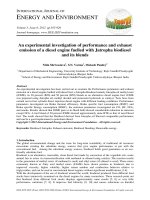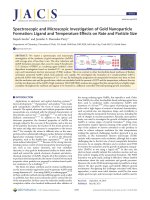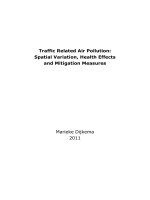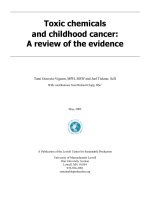WATER CONTAMINATION WITH TOXIC CHEMICALS AND HEALTH EFFECTS
Bạn đang xem bản rút gọn của tài liệu. Xem và tải ngay bản đầy đủ của tài liệu tại đây (239.94 KB, 14 trang )
WATER CONTAMINATION WITH TOXIC CHEMICALS AND HEALTH EFFECTS
The main source of drinking water pollution can be attributed to environmental
contamination with toxic chemicals, discharge of untreated waste, and dumping of
industrial effluents. It is a generally accepted fact that the main problem of chemical
discharge into the water sources mainly groundwater.
GROUNDWATER CONTAMINATION
Ð Many areas of groundwater and surface water are now contaminated with heavy metals,
POPs (persistent organic pollutants), and nutrients that have an adverse affect on health.
Ð Ground water can be contaminated through various sources and some of these are
mentioned below:
@=1=Contamination of the environment and dispersion trough infiltration, evaporation,
winds, and rain, containing pesticides contaminate the water.
@=2=Groundwater is susceptible to contamination, as pesticides are mobile in the soil. It is
a matter of concern as these chemicals are persistent in the soil and water.
@=3=Leechate from landfill sites is a major contaminating source: SEE MY REPORT ON THE
ORDOT DUMPSITE
@=4=There are more than 100 Ground Water Wells in this part of the island (North). Some of
these wells are connected trough conduits that flow out as springs or seeps along Tumon Bay
(South). Studies conducted in 2001 by the Environmental Protection Agency (EPA) of Guam, on
the spring waters that discharged from the northern lens acquifer in Guam, reported unusually
high levels of Arsenic.
@=5=Where toxic chemicals are present in high concentrations in the
environment, groundwater gets contaminated and this leads to the chemical
contamination of drinking water.
Chemicals in drinking water
Chemicals in water can be
both naturally occurring or
introduced by human
interference and can have
serious health effects.
1. Petrochemicals.
Petrochemicals
contaminate the
Petrochemicals are chemical productsgroundwater
made from raw
frommaterials of petroleum
(hydrocarbon) origin.
underground
petroleum storage
The two main classes of raw materialstanks.
are olefins (including ethylene and propylene) and
aromatics (including benzene and xylene isomers), both of which are produced in very large
quantities, mainly by the steam cracking and catalytic reforming of refinery hydrocarbons.
From these basic building blocks are made a very wide range of raw materials used in
industry - plastics, resins, fibres, solvents, detergents, etc.
GUAM: VOLATILE ORGANIC COMPOUND (VOC) IN THE ENVIRONMENT:
A. Trichloroethylene (TCE):
Federal Agency for Toxic Substances & Disease Registry (ATSDR)
TCE: sites, dates, and concentrations/comparison values (CVs).
Groundwater from Downgradient Wells of Each Site
This area (Yigo) has over 100 interconnected wells
❒ GUAM, YIGO – (SITE NO. 33)
Drum Storage Area. No.2-Operable Unit. Main Base:
Active drum storage area for asphalt, paints, oil, tar, &
contaminated soil from underground storage tank
removals.
PCE:
concentrations
drinking water CV.
❒ GUAM,
MARBO“above”
– (SITE the
NO.ATSDR
37)
War Dog Borrow Pit-Operable Unit. MARBO Annex: is an abandoned quarry.
Its contents and dates of operation are
unknown.
TCE : concentrations“above”
❒ GUAM,
MARBO – (SITE NO.the
22)ATSDR drinking water CV
Waste Pile No.6 (formerly Landfill No. 27)-Operable Unit.MARBO Annex: contains construction
debris.
Dates of operation are unknown.
PCE: concentration“above” the ATSDR “drinking water” CV.
❒ GUAM, YIGO – (SITE NO. 2)
Landfill No.2/Landfill No.4/Landfill No.5 (4 & 5 are contained within 2)-Operable Units. Main Base:
was used from 1947 to 1975, with a small area active until 1982. Materials disposed of at this site include
petroleum, oil, lubricants, solvents, pesticides, ferrous metal, construction debris, and unexploded
ordinance.
TCE: concentrations“above” the ATSDR drinking water CV
❒ GUAM, YIGO – (SITE NO. 8)
Landfill No. 10/Landfill No. 11/Landfill No. 12. Operable Units. Main Base. LF-10: used from the early
to mid-1950 to dispose of asphalt wastes, scrap metals, empty 55-gallon drums, sanitary wastes,
construction debris, occasional waste POL, and solvents. LF-11: used in the early 1950s as a disposal area
for asphaltic material, empty 55-gallon drums, and construction debris. LF-12: used in the late 1950s to
dispose of sanitary trash and asphaltic wastes.
PCE: concentrations “above” the ATSDR drinking water CV.
❒ GUAM, MARBO – (SITE NO. 38)
MARBO Laundry Facility-Operable Unit. MARBO Annex
PCE: concentrations “above” the ATSDR drinking water CV.
EXPOSURE
The US Air
Force began
1. Tetrachloroethylene (TCE) is a synthetic uses
chemical
TCE,that
an is widely used for metal-degreasing
operations. Other names for tetrachloroethylene
include
perchloroethylene, PCE, pert,
industrial
tetrachloroethene, perclene, and perchlor. solvent, to
degrease
2. TCE enters the environment mostly by evaporating
into the air during use. It gets into surface
airplane parts.
water supplies and the soil during disposal of sewage sludge and when leaking from
underground storage tanks.
3. Tetrachloroethylene may also get into the air, soil, or water by leaking or evaporating from
storage and waste sites.
4. TCE can stay in the air for several months before is brought back down to the soil and water
by rain.
5. Much of the tetrachloroethylene that gets into water and soil will evaporate into the air. However,
because tetrachloroethylene can travel through soils quite easily, it can get into
underground
drinking water supplies. If it gets into underground water, it may stay there
for
6. many
TCE can enter the body when people breathe air containing it, or when they drink
months.
water
HEALTH EFFECTS
A. Statements by Federal Authorities:
▪
US Senators--Hillary Rodham Clinton, Barbara Boxer, Christopher J. Dodd, Frank
Lautenberg, Joseph I. Lieberman, Gordon Smith, and Ron Wyden in written appeal to EPA
for better public protection against TCE:
"TCE...is known to cause cancer and damage the nervous and immune systems. Children and
seniors are especially vulnerable to TCE’s toxic effects... Today, thousands of Americans may
be exposed to unhealthful levels of TCE."
▪
Walter Mugdan, Director, Division of Environmental Planning and Protection, US EPA in
Vapor Intrusion, The Next Big Thing, August, 2006:
"The major implication of the new findings is, of course, that human exposures at potentially
dangerous levels may have occurred for years or decades, even after a site was recognized and
(as we thought), satisfactorily addressed. We may presume that our relative ignorance in this
arena will unfortunately have contributed to some number of additional cancers or other
illnesses that could have been prevented."
B. Studies
Studies by the National Research Council, sponsored by the U.S. Department of Defense, the
U.S. Department of Energy, the U.S. Environmental Protection Agency, and the National
Aeronautics and Space Administration, shows that TCE (Trichloroethylene) is:
1.
2.
3.
4.
5.
Nephrotoxic
Nephrocarcinogenic
Cardiac teratogenesis
Cause of infertility in
males and females
Cause of impaired
fetal growth.
GUAM: VOLATILE ORGANIC COMPOUND (VOC) IN THE ENVIRONMENT:
B. BTEX (benzene, toluene, ethylbenzene, and xylenes)
Federal Agency for Toxic Substances & Disease Registry (ATSDR) BTEX:
sites, dates, and concentrations/comparison values (CVs).
Groundwater from Downgradient Wells of Each Site
❒ GUAM, YIGO – (SITE NO. 26)
Fire Training Area No.2. Main Base: used between 1958 and 1988
BTEX: concentrations “above” CVs---- up to: 7,200 ppb
EXPOSURE
a)
Benzene, toluene, ethylbenzene, and xylenes (BTEX)
frequently occur together at hazardous waste sites. The
fouracutely
chemicals
andmobile
have solvent
properties.
b) BTEX compounds are among the most
toxicare
andvolatile
the most
in soil and
groundwater, with the potential to move through soil and contaminate ground water, and
their vapors are highly flammable and explosive.
c) BTEX compounds can pose a drinking water hazard when they accumulate in ground water.
HEALTH EFFECTS
BTEX compounds are well absorbed, distribute to lipidrich and vascular tissues such as the brain, bone marrow,
and body fat due to their lipophilicity.
A. Chronic potential hazards include harmful effects to the:
•
•
•
•
•
•
Liver
Kidneys
Heart
Lungs
Nervous System, including neurological impairment
Anemia, with subsequent manifestation of Acute Myelogenous Leukemia.
B. Acute hazards include:
Potential acute toxicity to aquatic life in the water column, as well as
potential inhalation hazards.
2. Arsenic.
Arsenic occurs naturally or is possibly
aggrevated by over powering aquifers and by
phosphorus from fertilizers. High
concentrations of arsenic in water can have an
adverse effect on health.A few years back, high
concentrations of this element was found in
drinking water in six districts in West Bengal. A
majority of people in the area was found
suffering from arsenic skin lesions. It was felt
GUAM: ARSENICthat
IN arsenic
THE ENVIRONMENT
contamination in the
Federal
Agency
for
Toxic
Substances
& Disease
Registry
groundwater was due to natural causes. The government
is trying
to provide an
(ATSDR)
Arsenic:
sites,
dates,
and
alternative drinking water source and a method through which the arsenic content from
concentrations/comparison values (CVs).
water can be removed.
Shallow Subsurface Soil:
ATSDR: average level of
Arsenic in soil: 3-4 ppm.
❒ GUAM, YIGO – (SITE NO. 27)
Hazardous Waste Storage Area No.1. Main Base: beginning in 1950 and continuing through the
1970s, petroleum, oil, lubricants, and solvents were stored. From the late 1970s to 1983 was used
to store hazardous wastes.
Arsenic: concentration “above” CVs----up to 201 ppm
❒ GUAM, YIGO – (SITE NO. 28)
Chemical Storage Area No.1. Main Base: in the early 1970s, the site may have been used for the
disposal of waste petroleum, oils, lubricants, and chlorinated solvents. About 70% of the site is
filled material covered with vegetative cover.
Arsenic: concentrations “above”CVs----up to 15 ppm
❒ GUAM, YIGO – (SITE NO. 4)
Landfill No.6. Main Base: operated from 1953 to 1954.
Twenty surface soil samples were analyzed. Results--Arsenic: concentrations “above”
for a child
CVs
EXPOSURE
The scientific literature about the toxicity of arsenic is
extensive, containing a large number of studies of
exposed human populations, in whom the main route
of exposure is oral. These studies have identified
effects on
virtually every organ or tissue evaluated.
HEALTH
EFFECTS
A. CANCER
The
Department of
Health and
Human
Services
(DHHS):
carcinogen by the inhalation and oral routes, and has assigned it the cancer classification, Group
A.
The International Agency for Research on Cancer (IARC): cites sufficient evidence of a
relationship between exposure to arsenic and human cancer. The IARC classification of arsenic
is Group 1.
Main
ofCancer:
cancer related
arsenic
exposure:
• types
Lung
there istoclear
evidence
from studies in humans that exposure to inorganic
arsenic by either the inhalation or oral routes increases the risk of cancer. Numerous
studies have reported an increased risk of lung cancer.
• Skin Cancer: there is convincing evidence from a large number of epidemiological
studies and case reports that ingestion of inorganic arsenic increases the risk of
developing skin cancer. The most common tumors seen are squamous cell carcinomas,
which may develop from the hyperkeratotic warts or corns commonly seen as a dermal
effect of oral inorganic arsenic exposure.
•
Bladder Cancer: there is increasing evidence that long-term exposure to arsenic can
result in the development of bladder cancer, with transitional cell cancers being the
most prevalent.
•
Tranplacental Cancer: a recent study in mice reported that arsenic could function as a
complete transplacental carcinogen, resulting in tumors in the offspring of exposed
animals.
B. CARDIOVASCULAR
A large number of studies
in humans have reported
cardiovascular effects
a. Altered Myocardial Depolarization
following oral exposure to
b. Cardiac Arrhythmias
inorganic arsenic
c. Ischemic Heart Disease. compounds. The cardiac
effectsand
of long-term
arsenic exposure
These effects have been seen after acute
exposure to inorganic arsenic in the
are
numerous,
andhas
include:
environment. Chronic exposure to inorganic arsenic
also been shown to lead to effects on the
vascular system. The most dramatic of these effects is “Blackfoot Disease”, a disease
characterized by a progressive loss of circulation in the hands and feet, leading ultimately to
necrosis and gangrene. Arsenic exposure has also been associated with an increased incidence of
cerebrovascular and microvascular diseases and ischemic heart disease. Other vascular effects
are common in areas with arsenic exposures, include such severe effects as increases in the
incidences of Raynaud's disease and of cyanosis of fingers and toes as well as hypertension,
thickening and vascular occlusion of blood vessels, and other unspecified cardiovascular
conditions.
C. NEUROLOGICAL
1. Encephalopathy.
2. Peripheral Neuropathy.
3. Children: decreases in intelligence scores.
D. SKIN
a. Hyperkeratinization
b. Hyperpigmentation.
3. Lead.
Pipes,
fittings,
solder,
GUAM: LEADand
IN the
THE ENVIRONMENT
service
Federal Agency for Toxic Substances & Disease Registry (ATSDR)
connectio
Lead: sites, dates, and concentrations/comparison
values (CVs).
ns of
A. Shallow
some Subsurface Soil
household
EPA: Uncontaminated
soil-concentrations of less than
plumbing
50 ppm. Soil cleanup level-400 ppm
❒ GUAM, YIGO – (SITE NO. 10). systems
contain
Landfill No.14. Main base: contains concrete
debris and construction
lead that
debris.
contamin
ates
the
Lead: concentrations “above”
CVs----up
to 40,000 ppm
❒ GUAM, MARBO – (SITE NO. 22) drinking
Waste Pile No. 6 (formerly known as Landfill
water No. 27). MARBO Annex: contains construction
debris.
source.
Dates of operation are unknown.
Lead : concentrations “above” CVs ---- up to 6,500 ppm
❒ GUAM, MARBO – (SITE NO. 24)
Landfill No.29. MARBO Annex: is littered with household debris and garbage.
Dates of operation are unknown.
Lead: concentrations “above” CVs ---- up to 1,100 ppm
❒ GUAM, YIGO – (SITE NO. 28)
Chemical Storage Area No. 1. Main Base: in the early 1970s, the site was used for the disposal of
waste petroleum, oils, lubricants, and chlorinated solvents.
About 70% of the site is filled material covered with vegetative cover.
Lead: concentrations “above” CVs ---- up to 770 ppm
❒ GUAM, NORTHWEST FIELD – (SITE NO. 31).
Chemical Storage Area No. 4. Northwest Field: waste oils and solvents were stored at this
site.
Lead: concentrations “above” CVs --- up to 3,100 ppm
❒ GUAM, YIGO – (SITE NO. 27).
Hazardous Waste Storage Area No. 1. Main Base: beginning in 1950 and continuing through the
1970s, petroleum, oil, lubricants, and solvents were stored. From the late 1970s to 1983 was
used to store hazardous wastes.
Lead : concentration “above” CVs----up to 8,600 ppm
❒ GUAM: NORTHWEST FIELD - (SITE NO. 16).
Landfill No. 21. Northwest Field: operated as a sanitary trash disposal
site.
Lead: concentrations “above” CVs----up to 16,000 ppm
❒ GUAM, YIGO – (SITE NO. 5).
Landfill No. 7. Main Base.
Lead: concentrations “above” CVs
❒ GUAM, MARBO – (SITE NO. 38)
MARBO Laundry Facility. MARBO Annex.
Lead: concentrations “above” CVs ---- up to 15,700 ppm
B. Groundwater from Downgradient Wells of Each Site
❒
GUAM, YIGO – (SITE NO. 1)
Landfill No. 1. Operable Unit. Main Base: opened in 1945 and continues to be used today.
Materials disposed of include waste petroleum, oil, lubricants (POL), solvents, ferrous metal,
construction debris, and pesticides
Lead: concentration“above” drinking water comparison values (CVs)
❒ GUAM, MARBO – (SITE NO. 24)
Landfill No. 29 (LF-29). OU: MARBO Annex. LF-29 is littered with household debris and
garbage.
Dates of operation are unknown.
Lead: present/concentration not-specified
EXPOSURE
A common source of lead contamination are landfills
that contain waste of lead-containing products
(i.e. ammunition in military bases, or waste and
A. Contamination of the Environment
debris of certain activities)
1.
Once lead falls onto soil, it sticks strongly to soil particles and remains in the upper layer of
soil, and part of it may enter rivers, lakes, and streams when soil particles are moved by
rainwater.
2.
Sources of lead in dust, soil, and groundwater include lead that falls to the ground from the
air. Once lead that gets into the atmosphere, may travel long distances if the lead particles
are very small
3. Lead may remain stuck to soil particles or sediment in water for many years.
4. The levels of lead may build up in plants and animals from areas where air, water, or soil are
contaminated with lead.
5. If animals eat contaminated plants or animals, most of the lead that they eat will pass through
their bodies.
B. Exposure of the population to lead
a)
People living near hazardous waste sites are exposed to lead and
chemicals that contain lead by breathing air, drinking water,
foods,
orfood,
swallowing
dust
or dirt
that contain
b) People may be exposed toeating
lead by
eating
drinking
water,
or breathing
in lead.
or swallowing
airborne dust and dirt.
c) Leafy fresh vegetables may have lead-containing dust on them. Children may be exposed to
lead by hand-to-mouth contact after exposure to lead-containing soil or dust.
d) Some of the lead that enters the human body comes from breathing in dust or chemicals that
contain lead. Once this lead gets into the lungs, it goes quickly to other parts of the body in
the blood.
e) Lead can also enter the body by swallowing food or drinking liquids that contain it.
f)
Dust and soil that contain lead may get on the skin.
g) Shortly after lead gets into the body, it travels in the blood to the "soft tissues" and organs
(such as the liver, kidneys, lungs, brain, spleen, muscles, and heart).
h) After several weeks, most of the lead moves into the bones and teeth. Some of the lead can
stay in the bones for decades; however, some lead can leave the bones and reenter the
blood and organs under certain circumstances (e.g., during pregnancy and periods of
breast- feeding, after a bone is broken, and during advancing age).
HEALTH EFFECTS
•
•
An enormous amount of information is available on the health effects of lead on human
health. In fact, the toxic effects of lead have been known for centuries, but the discovery in
the past few decades that levels of exposure resulting in relatively low levels of lead in
blood associated with adverse effects in the developing organism is a matter of great
concern.
The most sensitive targets for lead toxicity are the developing nervous system, the
hematological and cardiovascular systems, and the kidney. However, due to the multi-modes
of action of lead in biological systems may affect any organ in the body, including:
1.
Encephalitis, Parkinson's Disease, Multiple Sclerosis, Myelopathy (spinal
cord pathology), Epilepsy, Peripheral Neuropathies, Seizures.
2. Memory Loss (long term), Attention Deficit Disorder, Autism, Schizophrenia,
Concentration Loss, Emotional Instability, Hallucinations, Depression, Dyslexia,
Behavioral Disorders, Hyperactivity, Learning Disability.
3.
Arthritis (rheumatoid and osteo), Gout, Muscular Dystrophy, Joint Pain, Cartilage
Destruction.
4.
Nephritis, Renal Dysfunction
5. Cardiovascular Disease, Anemia, Hypertension.
6. Adrenal Insufficiency, Hypothyroidism.
7. Stillbirths, Sterility, Infertility, Sudden Infant Death Syndrome.
8. Liver Dysfunction.
10.
Immune Suppression.
9. Deafness,
Blindness.
Recommendations of the federal government to protect the health of the community:
• CDC:
Recommends that states develop a plan to find children who may be exposed to lead and have
their blood tested for lead. CDC recommends that the states test children: at ages 1 and 2 years;
at ages 3-6 years if they have never been tested for lead; and if they receive services from public
assistance programs for the poor.
• EPA :
Developed regulations limiting lead in drinking water to 0.015 milligrams per liter (mg/L),
although the goal is that drinking water be free of lead.
• The 1988 Lead Contamination Control Act:
The Control Act requires the Consumer Product Safety Commission, EPA, and the states:
That drinking water in schools must be tested for lead, and the sources of lead in this water must
be removed.
Pesticides.
GUAM: PESTICIDES IN THE ENVIRONMENT
Federal Agency for Toxic Substances & Disease Registry (ATSDR)
Pesticides: sites, dates, & concentrations/comparison values (CVs).
ATSDR produced the: “Report of the United States Agency for Toxic Substances and Diseases
Registry, Public Health Assessment. Andersen Air Force Base, Yigo, Guam. EPA Facility ID:
GU 6571999519. January 4, 2002. Prepared by Federal Facilities Branch, Division of Health
Assessment and Consultation, Agency for Toxic Substances and Disease Registry (ATSDR). (1)
The sources for ATSDR’s report, are:
a) Andersen Air Force Base. Yigo, Guam: 1998b, 1998c, 1998d;
b) Andersen Air Force. Yigo, Guam. 1999c, 1999d, 1999e, 1999f, 1999g;
c) Anderson Air force Base, Yigo, Guam. 2000b, 2000c.
d)
e)
f)
United States Air Force (USAF):1992a, 1996, 1997, 2000.
SAIC 1991
Anderson Air Force Base. Yigo, Guam. EPA ID #: GU-6571999519. OU 07.
December 2003.
Groundwater
Wells:
❒ GUAM, MARBO – (SITE NO.
24)
Landfill No.29-Operable Unit. MARBO Annex: is littered with household debris and
garbage.
Dates of operation are unknown.
present/concentrations
❒ Pesticides:
GUAM, YIGO
– (SITE NO. 26) not-specified
Fire Training Area No.2-Operable Unit. Main Base: used between 1958 and
1988.
Pesticides: present at levels “above” CVs
❒ GUAM, YIGO – (SITE NO. 8)
Landfills No.10/Landfill No.11/Landfill No.12-Operable Units. Main Base. LF-10: used from the
early to mid-1950s to dispose of asphalt wastes, scrap metals, empty 55-gallon drums, sanitary
wastes, construction debris, petroleum, oil, lubricants, and solvents. LF-11: was used in the
early 1950s as a disposal area for asphaltic material, empty 55-gallon drums, and construction
debris. LF12: was used in the late 1950s to dispose of sanitary trash and small quantities of asphaltic wastes.
Pesticides: present/concentrations not-specified
There are more than 865 active ingredients registered as pesticides, which are formulated into
thousands of pesticide products that are available in the marketplace. About 350 pesticides are
used on the foods we eat, and to protect our homes and pets.
EXPOSURE
▪ Studies show that only 5% of pesticides reach target weeds. The rest, (95 % of the
pesticides) runs off into water or dissipates in the air. Drift from landscaping can range from
12 feet to 14.5 miles. Guam is 30 miles x 10 miles.
▪ Pesticides can be absorbed through the skin, swallowed or inhaled. Pesticides often stray
from their point of application to settle on neighbors' properties, clotheslines, pools, toys
and furniture.
▪ Children and pets often track pesticide residues into the house.
▪ Effects that are more serious appear to be produced by direct inhalation of pesticide sprays
than by absorption or ingestion of toxins.
▪ Because safety testing has not been adequate, current pesticide applications are essentially a
giant experiment using the general public.
▪ In the US, it is a violation of federal law to state that the use of pesticides is safe, because
pesticides are toxic by definition.
HEALTH EFFECTS
A. Short/Single and Intermediate Exposure
? Neurotoxicity
B. Long-term exposure
? Cancer
? Birth Defects
? Genotoxicity
? Hormone Disruption (development, growth, reproduction, and behavior)
Human Health Risk Assessment and the Law:
Federal law requires detailed evaluation of pesticides to protect human health and the
environment. In 1996, Congress made significant changes to strengthen pesticide laws through
the Food Quality Protection Act (FQPA). Many of these changes are key elements of the current
risk assessment process. FQPA required that EPA consider:
▪
▪
▪
A New Safety Standard: FQPA strengthened the safety standard that pesticides must meet
before being approved for use. EPA must ensure with a reasonable certainty that no harm
will result from the legal uses of the pesticide.
Exposure from All Sources: In evaluating a pesticide, EPA must estimate the combined risk
from that pesticide from all non-occupational sources, such as:
Food Sources
Drinking Water Sources
Residential Sources
Cumulative Risk: EPA is required to evaluate pesticides in light of similar toxic effects that
different pesticides may share, or “a common mechanism of toxicity”. At this time, EPA is
developing a methodology for this type of assessment.
▪
Special Sensitivity of Children to Pesticides: EPA must ascertain whether there is an
increased susceptibility from exposure to the pesticide to infants and children. EPA must
build an additional 10-fold safety factor into risk assessments to ensure the protection of
infants and children, unless it is determined that a lesser margin of safety will be safe for
infants and children.
4. Other heavy metals.
These contaminants come from mining waste and
tailings, landfills, or hazardous waste dumps.
5. Chlorinated solvents.
Metal and plastic
effluents, fabric cleaning,
electronic and aircraft
Synthetic organics.
manufacturing
are often
Many of the
100
discharged
and
000 synthetic
contaminate
compounds in use
groundwater.
today are found in
the aquatic
environment and
This is a Research Summary of Dr. Luis Szyfres, MD, MPH
accumulate in the
food chain. POPs or
Persistent organic
pollutants,
represent the most
harmful element for
the ecosystem and
for human health,
for example,
industrial chemicals
and agricultural
pesticides.









